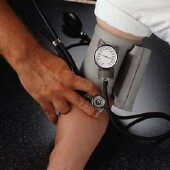
SUNDAY, Aug. 31 (HealthDay News) -- A new study offers a possible alternative to heart patients and diabetics who need to keep their blood pressure under control but who cannot tolerate the standard treatment of ACE inhibitors.
Reporting at the European Society of Cardiology in Munich on Sunday, Canadian researchers said they found that the angiogenesis-receptor blocker (ARB) known as telmisartan worked well for the 20 percent of patients with vascular disease and high-risk diabetes who can't take ACE inhibitors. The study was released in the Aug. 31 online issue of The Lancet to coincide with the meeting presentation.
In the randomized, controlled trial, almost 6,000 patients with vascular disease or high-risk diabetes took either telmisartan or a placebo, and were followed for almost five years. Rates of death, heart attack, stroke or hospitalization for heart failure were tracked as primary outcome measures during the study period.
Mean blood pressure was lower in the telmisartan group by 4.0/2.2 mm/Hg, and there was a relative risk reduction of 13.3 percent for those taking telmisartan. Fewer patients on the medication wound up in the hospital for cardiovascular problems (30.3 percent), compared to those on placebo (33 percent).
"These data suggest that telmisartan confers a modest benefit when added to other proven therapies," the researchers wrote in a news release from the journal. "In view of the drug's tolerability and effect on cardiovascular endpoints, telmisartan could be regarded as a potential treatment for patients with vascular disease or high-risk diabetes, if they are unable to tolerate an ACE inhibitor."
However, an accompanying commentary from U.S. experts dampened the significance of the finding.
"ARBs that have been studied in coronary disease are safe, but possibly less effective alternatives in patients with intolerance to ACE inhibitors. Although data are too limited to reach definitive conclusions, the clinical effect of ARBs seems less robust than that of ACE inhibitors," wrote Dr. Toni Ripley and Dr. Donald Harrison, from the University of Oklahoma College of Pharmacy.
And U.S. researchers reported on Wednesday that telmisartan does not lower the rate of stroke, cardiovascular events or diabetes better than a placebo in patients who have had a stroke.
More information
For more on ARBs, go to U.S. Food and Drug Administration.

WEDNESDAY, Aug. 27 (HealthDay News) -- Scientists have succeeded in transforming pancreatic cells from adult mice into insulin-producing beta cells, a feat they call an "extreme makeover."
The achievement is a step toward finding a treatment or even a cure for both type 1 and type 2 diabetes, both of which involve problems with either insulin production or uptake.
The process, reported online Aug. 27 in Nature, bypassed some of the steps usually required in this type of procedure.
"The presently accepted regenerative medicine idea is that you make a stem cell from a patient, bring it back to the beginning as it were, then you are left with the problem of how to instruct that cell to become a beta cell or a motor neuron," explained study author Douglas Melton, co-director of the Harvard Stem Cell Institute, at a Tuesday teleconference. "We asked the simple question, why should you have to go all the way back to the beginning? Could you go from one cell type to another?"
"Up to this time, we hadn't demonstrated that you could do direct reprogramming," added Melton, who admitted to being "obsessed" with finding a cure for type 1 diabetes.
Here, Melton and his colleagues converted exocrine cells of the pancreas into neighboring endocrine cells. The process involved injecting three transcription factors -- genes which encode proteins that turn on and off other sets of genes -- into the pancreases of adult mice.
The process was surprisingly efficient, with some 20 percent of cells that received the three genes converting into beta cells.
Although these cells did ease hyperglycemia in diabetic mice, they did not respond to glucose, meaning there is still a way to go before finding a treatment or cure for the disorder.
Next, scientists are faced with the not insubstantial task of taking human cells, reprogramming them into beta cells, then coalescing them into islets or groups of beta cells to transplant into patients.
Currently, some diabetics are treated with islets taken from human cadavers, but it takes two cadavers to provide enough cells for one patient. Another option would be to convert liver cells into beta cells.
"One present treatment for some diabetics is to transplant islets into the liver, so we know that liver cells are a reasonable home for beta cells," Melton said. "If we're lucky, in two to five years, we can think about doing that in people."
It's unclear at this point, however, if three genes will be enough to accomplish this feat, given that liver cells are more distantly related to beta cells than are exocrine cells.
Researchers are reluctant to inject directly into the pancreas, a "touchy" organ, Melton said. "If we physically inject something into the pancreas, it almost always induces pancreatitis," he said. "You could be causing more trouble than what you started with."
Melton stressed that it is still imperative to continue research into highly controversial embryonic stem cells as well as induced pluripotent stem cells.
"Maybe when the history of the whole subject is written, it will be possible to say which was the best idea," he said. "I can't emphasize enough at this point that we're too ignorant to know what is the best way to treat patients and, until we know that, it is essential that we use embryonic stem cells and iPS cells to teach us about the mechanisms of disease. Until we know how to succeed, we have to aggressively pursue all avenues."
It is hoped that whatever avenue finally succeeds will be able to generate treatments or cures for a variety of diseases, including neurodegenerative diseases and cardiovascular disease.
More information
The National Institutes of Health has more on stem cells.